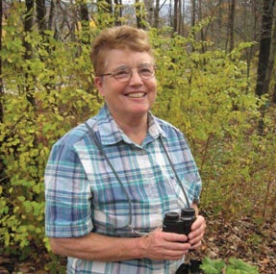
Through her efforts as a citizen scientist, Ruth Stewart has made invaluable contributions to the world of science and conservation.
I was forever looking for the perfect leaf—no imperfections, exceptional color. It could always be replaced the next day. I must have been 6 or 7 years old then, walking home from school in Detroit. Before my 8th birthday we moved to a farm in the Finger Lakes region of western New York. I had a bike, lots of countryside, forests, swimming holes, and an exploratory bent. Maybe it was that dead female opossum with young that fired my lifelong curiosity about the natural world. It was my first close-up look at a marsupial, and I almost took it home!
I chose college at the State University of NY at Albany for English and Library Science—not biology. That decision led me to a teaching/librarian career after I moved to Vermont. Always somewhat frustrated by the path not taken, I began learning about nature on my own. Identifying spring wildflowers was my first quest—stationary objects that could be photographed, examined, or torn apart if necessary. It was easy to combine the duties of young motherhood with a leisurely walk in the Vermont woods.
Then birding grabbed my attention. In the early 1970s, George Ellison and his teen son, Walter, offered a field birding “course” through the Vermont Institute of Natural Science (VINS). We traveled to hotspots like the Northeast Kingdom, Herrick’s Cove, Dead Creek, Newburyport, and Plum Island. It was my initiation to the world of birds, birding places, birding people, birding fanatics, and birding contagion. I’ve been hooked ever since.
What followed were many years of Vermont-based birding excursions and events offered by VINS. My favorite was the annual Bird Conference, with workshops on bird behavior, natural history, identification, and conservation, plus local field trips. Best of all were the renowned speakers sharing information about their ornithological travels and studies. These conferences maintained a flow of fresh and continuous learning, while providing an abundance of camaraderie, networking, and lifelong friendships.
When statewide citizen scientist projects began, I jumped on board as a less-than-skilled, but enthusiastic and willing birder. I participated in the first Vermont Breeding Bird Atlas from 1976-1981. My experiences during this Atlas made me a much more knowledgeable and confident birder, such that I “graduated” to become a Bennington County Coordinator for the second-generation Atlas in 2003. At the same time, the Vermont Butterfly Survey was launched, providing me an opportunity to learn about a new taxonomic group and contribute data to a valuable conservation project. I was newly retired, and for the first time in my life I had plenty of time to enjoy my outdoor passions. Both Atlases provided an excuse and a purpose to be outside, exploring new areas of Vermont, and contributing important data for conservation. I am sorry that the field work is over!
Vermont eBird is an ongoing project that is perfect for citizen scientists like me. It provides an opportunity to share bird records with others and to make one’s own observations permanently accessible for research and conservation. Observations entered in the eBird database can be used to help understand phenomena from local population dynamics, to migration timing, to the global biodiversity of bird populations.
For more than 30 years, I have been an avid student of natural history, an environmental advocate, conservationist, citizen scientist, and teacher. I still conduct annual point count surveys for VCE’s Forest Bird Monitoring Program and Cornell’s Birds in Forested Landscapes program, and I coordinate the Winhall Christmas Bird Count for Audubon. In addition, I count monarch larvae and butterflies for Monarch Watch. I have conducted birding workshops and talks, led bird walks, educated summer day campers about birds, and participated in Earthwatch natural history projects. My passion for birding has taken me to every continent except Antarctica (but there’s still time!). My avocation is birder and naturalist—a dabbler in much, a master of little. Life is a continuous learning experience. My life is enjoying where I am and what I am doing at the moment. Knowing that my small contributions as a citizen scientist add to understanding the bigger picture is part of that enjoyment.
—Ruth Stewart
